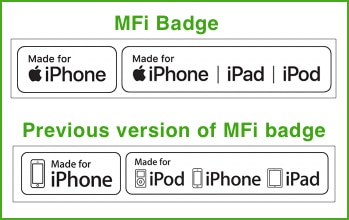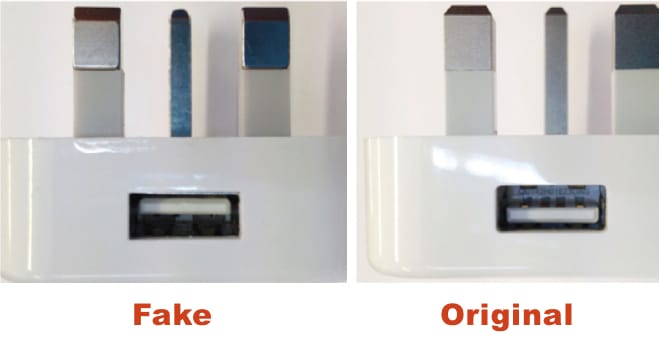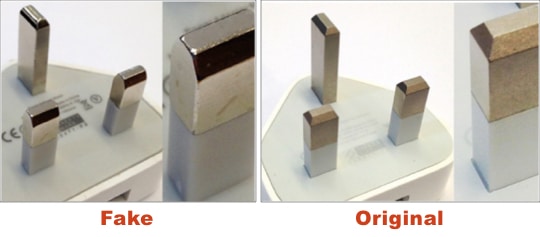Counterfeit Apple chargers are getting harder to detect, with replicas looking very similar to authentic ones—at least outwardly. You may need to open and check the product’s components to know for sure. The good thing is that there are many ways to spot a fake Apple charger. Below, I’ll discuss all the telltale signs that what you have with you is a fake Apple charger—and why you should get rid of it ASAP.
The danger of using a counterfeit Apple charger
Legitimate manufacturers like Apple and third-party vendors undergo strict measures to ensure that their products meet government and safety standards. In contrast, knockoffs are produced with only profitability in mind. These devices are unlikely to have undergone or passed the same safety testing as the original chargers. They make them as cheap as possible without putting any premium on their safety and reliability. An old 2016 report shows that a whopping 99% of the chargers failed basic safety tests and are shock and fire hazards. A similar test conducted in 2017 by UK’s electrical safety experts found that 98% of counterfeit and imitation chargers failed one or more mechanical and electrical tests and are not suitable to be sold and used. At the very least, these fake Apple chargers risk damaging the connected device. Worse, these charging devices may overheat, catch fire, deliver a serious electric shock, or even electrocute a person. There are stories of these fake chargers suddenly exploding or electrocuting a person while using their device plugged into an energy source.
Problems you may face with a fake Apple charger
If you use an uncertified or counterfeit Apple charger, these are some things that you’ll likely experience:
it may damage your device it might fall off or not attach or fit appropriately into your device the connection end might get too hot it might be incompatible with your device, making charging or syncing impossible
This is the common culprit behind the “This accessory may not be supported” issue.
How to spot a fake Apple charger
You don’t have to have specialized equipment to identify counterfeits. Let me teach you a few ways to identify a fake Apple charger. Below are real and fake examples of Apple chargers. While most are easy, it would be helpful if you have a genuine product to compare with or if you have a person who is familiar with genuine products.
Box
The easiest way to identify counterfeit cables and accessories is by inspecting their packaging. You should look for the MFi badge on their packaging. This spares you from buying a fake. While many counterfeit has upped their game to even copy the MFi labels on their boxes, many other fakes don’t—so it can still be helpful. Some people look and check for the Apple charger’s serial number. However, these are not so reliable since counterfeit products can also copy and use serial numbers.
Text and markings
Look at the plug face and inspect for errors like spelling mistakes, wrong spaces, and more. They may also be missing marks. Be sure to check the manufacturer’s logo, model, and batch number. You should also see the “CE” safety marked. However, this can easily be forged. Inspect the Apple Lightning to USB cable. It should have a “Designed by Apple in California” and either “Assembled in Vietnam,” “Assembled in China,” or “Indústria Brasileira” found seven inches from the USB connector. You should also see a 12-digit serial number after this text.
Lightning to USB cable and connector
You should also inspect the connector end or the parallel gold or silver-colored contacts at the connector. You should see a single piece, smooth, rounded contacts. Uncertified or counterfeit Apple chargers are made of more than one piece. Fake connectors appear rough, with an uneven or inconsistent finish. It may also be square instead of round. Genuine lightning to USB boot is consistent at 7.7 millimeters (mm) by 12 mm. Many counterfeit Apple chargers have boots that vary in length. Original connectors also come with grey or metallic faceplate inserts. If you see inserts that are white or black, these are fake. If you’re looking into the best USB-C chargers for your iPhone, we’ve got you covered. You may also want to look into cordless chargers for your iPhone, which are said to be more durable than their wired counterparts.
USB connector end
A genuine Apple charger’s USB-connector end has trapezoidal interlocks on the shell. These interlocks are equally spaced from the edges. Counterfeit chargers have right-angle interlocks that are inconsistently spaced. The USB contacts of genuine Apple chargers are gold-plated, while fake Apple chargers are silver-plated. The surface of the USB shell is flat and has a smooth, consistent texture. Meanwhile, it’s typical for a fake charger to have a rough or grainy USB surface. When you peek inside, the surface of the insulator should be uniform and flat. You might spot notches or indents on fake ones.
USB port
Now it’s time to look at the Apple power adapter. An original USB port has a serial number on the back of the USB port. Fake USB ports have irregular orientation.
Plug pins
The plug pins on fake Apple chargers can vary significantly from the positioning and dimensions required for safety. These may be harder to check and require a plug checker. They should have a matte, high-quality finish. Meanwhile, most fake Apple chargers are glossy and shiny. They can also be irregular or show tiny gaps. You can check if the plug pins are not fake by plugging the charger into the socket. Do this without connecting to any device. Check if the charger fits easily. There should be a minimum of 9.5 mm between the pins’ edge and the charger’s edge.
Materials
Counterfeit chargers are made of weaker materials. Pins are typically made of metal-coated hollow plastic, while genuine Apple accessories are made of solid metal. One easy way to check is to flick the pin and listen to the sound it makes. Counterfeit ones will make a hollow, plasticky sound instead of a solid metal sound.
Weight
Counterfeit products use poorer quality materials and contain very few components that ensure the product’s safety. For example, the wires in fake chargers are not secured or protected, and the transformer windings are not adequately insulated. Chargers should weigh at least 40 grams (g). Anything significantly lighter might be fake.
Warnings and instructions
Another place to check is the user manual. Because user manuals contain considerable detail about the product, it’s not uncommon to spot errors. For one, manuals with original Apple products come with professional binding, while fake ones are held with a big staple. Misalignments, spelling errors, and unusual spacings are also common.
Price
This is a dead give-away, but an unusually low price for an Apple adapter is a telltale sign that it is a counterfeit. Wrapping up… Counterfeit products are everywhere. If you’re tempted to buy a fake Apple charger because of its cheap price, remember the potential hazards it will bring. Not only can it damage your device, but it can overheat and potentially shock or catch fire. To be safe, it is best to buy Apple accessories directly from Apple or reputable suppliers and third-party vendors certified by Apple. Read more:
How to spot fake AirPods? Real vs. fake AirPods Pro: How to spot fake AirPods Pro How to get rid of fake Apple security alerts on iPhone




title: “How To Identify A Fake Apple Charger” ShowToc: true date: “2023-06-13” author: “Maria Adams”
Counterfeit Apple chargers are getting harder to detect, with replicas looking very similar to authentic ones—at least outwardly. You may need to open and check the product’s components to know for sure. The good thing is that there are many ways to spot a fake Apple charger. Below, I’ll discuss all the telltale signs that what you have with you is a fake Apple charger—and why you should get rid of it ASAP.
The danger of using a counterfeit Apple charger
Legitimate manufacturers like Apple and third-party vendors undergo strict measures to ensure that their products meet government and safety standards. In contrast, knockoffs are produced with only profitability in mind. These devices are unlikely to have undergone or passed the same safety testing as the original chargers. They make them as cheap as possible without putting any premium on their safety and reliability. An old 2016 report shows that a whopping 99% of the chargers failed basic safety tests and are shock and fire hazards. A similar test conducted in 2017 by UK’s electrical safety experts found that 98% of counterfeit and imitation chargers failed one or more mechanical and electrical tests and are not suitable to be sold and used. At the very least, these fake Apple chargers risk damaging the connected device. Worse, these charging devices may overheat, catch fire, deliver a serious electric shock, or even electrocute a person. There are stories of these fake chargers suddenly exploding or electrocuting a person while using their device plugged into an energy source.
Problems you may face with a fake Apple charger
If you use an uncertified or counterfeit Apple charger, these are some things that you’ll likely experience:
it may damage your device it might fall off or not attach or fit appropriately into your device the connection end might get too hot it might be incompatible with your device, making charging or syncing impossible
This is the common culprit behind the “This accessory may not be supported” issue.
How to spot a fake Apple charger
You don’t have to have specialized equipment to identify counterfeits. Let me teach you a few ways to identify a fake Apple charger. Below are real and fake examples of Apple chargers. While most are easy, it would be helpful if you have a genuine product to compare with or if you have a person who is familiar with genuine products.
Box
The easiest way to identify counterfeit cables and accessories is by inspecting their packaging. You should look for the MFi badge on their packaging. This spares you from buying a fake. While many counterfeit has upped their game to even copy the MFi labels on their boxes, many other fakes don’t—so it can still be helpful. Some people look and check for the Apple charger’s serial number. However, these are not so reliable since counterfeit products can also copy and use serial numbers.
Text and markings
Look at the plug face and inspect for errors like spelling mistakes, wrong spaces, and more. They may also be missing marks. Be sure to check the manufacturer’s logo, model, and batch number. You should also see the “CE” safety marked. However, this can easily be forged. Inspect the Apple Lightning to USB cable. It should have a “Designed by Apple in California” and either “Assembled in Vietnam,” “Assembled in China,” or “Indústria Brasileira” found seven inches from the USB connector. You should also see a 12-digit serial number after this text.
Lightning to USB cable and connector
You should also inspect the connector end or the parallel gold or silver-colored contacts at the connector. You should see a single piece, smooth, rounded contacts. Uncertified or counterfeit Apple chargers are made of more than one piece. Fake connectors appear rough, with an uneven or inconsistent finish. It may also be square instead of round. Genuine lightning to USB boot is consistent at 7.7 millimeters (mm) by 12 mm. Many counterfeit Apple chargers have boots that vary in length. Original connectors also come with grey or metallic faceplate inserts. If you see inserts that are white or black, these are fake. If you’re looking into the best USB-C chargers for your iPhone, we’ve got you covered. You may also want to look into cordless chargers for your iPhone, which are said to be more durable than their wired counterparts.
USB connector end
A genuine Apple charger’s USB-connector end has trapezoidal interlocks on the shell. These interlocks are equally spaced from the edges. Counterfeit chargers have right-angle interlocks that are inconsistently spaced. The USB contacts of genuine Apple chargers are gold-plated, while fake Apple chargers are silver-plated. The surface of the USB shell is flat and has a smooth, consistent texture. Meanwhile, it’s typical for a fake charger to have a rough or grainy USB surface. When you peek inside, the surface of the insulator should be uniform and flat. You might spot notches or indents on fake ones.
USB port
Now it’s time to look at the Apple power adapter. An original USB port has a serial number on the back of the USB port. Fake USB ports have irregular orientation.
Plug pins
The plug pins on fake Apple chargers can vary significantly from the positioning and dimensions required for safety. These may be harder to check and require a plug checker. They should have a matte, high-quality finish. Meanwhile, most fake Apple chargers are glossy and shiny. They can also be irregular or show tiny gaps. You can check if the plug pins are not fake by plugging the charger into the socket. Do this without connecting to any device. Check if the charger fits easily. There should be a minimum of 9.5 mm between the pins’ edge and the charger’s edge.
Materials
Counterfeit chargers are made of weaker materials. Pins are typically made of metal-coated hollow plastic, while genuine Apple accessories are made of solid metal. One easy way to check is to flick the pin and listen to the sound it makes. Counterfeit ones will make a hollow, plasticky sound instead of a solid metal sound.
Weight
Counterfeit products use poorer quality materials and contain very few components that ensure the product’s safety. For example, the wires in fake chargers are not secured or protected, and the transformer windings are not adequately insulated. Chargers should weigh at least 40 grams (g). Anything significantly lighter might be fake.
Warnings and instructions
Another place to check is the user manual. Because user manuals contain considerable detail about the product, it’s not uncommon to spot errors. For one, manuals with original Apple products come with professional binding, while fake ones are held with a big staple. Misalignments, spelling errors, and unusual spacings are also common.
Price
This is a dead give-away, but an unusually low price for an Apple adapter is a telltale sign that it is a counterfeit. Wrapping up… Counterfeit products are everywhere. If you’re tempted to buy a fake Apple charger because of its cheap price, remember the potential hazards it will bring. Not only can it damage your device, but it can overheat and potentially shock or catch fire. To be safe, it is best to buy Apple accessories directly from Apple or reputable suppliers and third-party vendors certified by Apple. Read more:
How to spot fake AirPods? Real vs. fake AirPods Pro: How to spot fake AirPods Pro How to get rid of fake Apple security alerts on iPhone



